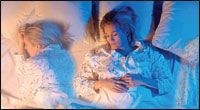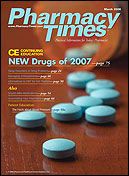Publication
Article
Pharmacy Times
Sleep Disorders: Treatment Options for a Tiring Problem
Author(s):
Various pharmacologic agents are available for sleep disorders, which affect a large portion of the US population.
Dr. Knudsen is an assistant professor of pharmacy practice at Midwestern University College of Pharmacy—Glendale, Glendale, Arizona.
In 2004, Surgeon General Richard H.Carmona estimated that sleep disorderscost the United States $15 billionin health care expenses and $50 billion inproductivity losses each year.1 Productivitylosses usually stem from excessivedaytime sleepiness, which is a symptomassociated with all sleep disorders.
Although insomnia is the most well-knownsleep disorder and has the mostpharmacotherapy options, the sleep-disordercategory actually contains 4 disorders—including narcolepsy (daytimesleep attacks), sleep apnea (breathinginterruptions during sleep), restless legssyndrome (RLS; a tingling or prickly sensationin the legs), and insomnia (difficultyfalling or staying asleep).2
Insomnia
Of the 4 sleep disorders, insomniaaffects the largest number of patients—an estimated 10% to 20% of the US population—and 47% of elderly patientsexperience chronic insomnia.3 In 2007,insomnia patients incur annual costsbetween $92.5 billion and $107.5 billion.4Although these numbers are staggering,so is the plethora of treatment options.

Medication classes available for insomniatreatment include: benzodiazepine(BZD) hypnotics, non-BZD hypnotics, amelatonin receptor agonist, and OTC antihistamines.Pharmacotherapy shouldinclude "use of the lowest effective dose,use of intermittent dosing (2-4 timesweekly), short-term medication prescribing(regular use for not more than 3-4weeks), and gradual medication discontinuationto reduce rebound insomnia."5
BZDs improve insomnia by "reducingREM sleep, decreasing sleep latency, anddecreasing nocturnal awakenings."6 Theyare initially very effective in inducing andprolonging sleep and are relatively inexpensive;however, many problems areassociated with them.
BZDs are associated with reboundinsomnia that can occur within 1 or 2weeks of use, hangover effects, tolerance(which can develop rapidly onrepeated administration), and addictionpotential.6 Whereas short-acting BZDsare preferred, both short-acting (eg,temazepam) and long-acting (eg,diazepam) agents have the potential tocause these problems.
Non-BZD hypnotics, like zolpidem(Ambien), zaleplon (Sonata), eszopiclone(Lunesta), changed the landscape ofinsomnia treatments. Ancoli-Israel andcolleagues described the benefits ofzaleplon in older adults during short- andlong-term treatment as having "no pharmacologictolerance developed duringtreatment and no rebound insomnia orwithdrawal symptoms after medicationdiscontinuation."7
As much as these agents have positiveaspects, adverse effects became apparentduring postmarketing monitoring.
In December 2006, the FDA askedmanufacturers of products approved forthe treatment of sleep disorders torevise their product labeling to includewarnings about potential adverse eventssuch as "anaphylaxis (severe allergicreaction) and angioedema (severe facialswelling), which can occur as early as thefirst time the product is taken," as well as"complex sleep-related behaviors, whichmay include sleep driving, making phonecalls, and preparing and eating food(while asleep)."8 Complex sleep-relatedbehaviors have received a great deal ofpress.9 At this time, the exact mechanismis not clear, nor is the commonality ofthese types of events in patients treatedwith these agents.
Ramelteon (Rozerem), a melatoninreceptor agonist, was included in thelabel revisions. Griffiths and colleaguesreported that, compared with 19 otheragents including non-BZDs, BZDs, anddiphenhydramine, ramelteon producedno detectable subjective effects thataffect likelihood of abuse at up to 20times the recommended therapeuticdose.10
Sleep Apnea
Sleep apnea causes repetitive episodesof upper airway occlusion during sleep.Although the mechanism of action of thiscondition does not seem to fall into thecategory of sleep disorder, it is the resultof excessive daytime sleepiness thatallows its inclusion. These repetitiveepisodes cause oxygen desaturation andsleep disruption.
Surgery, dental appliances, and continuouspositive airway pressure are thepreferred treatments. Antidepressants,protriptyline, or fluoxetine may be usedin combination with nonpharmacotherapytreatments to decrease excessivedaytime sleepiness because of their suppressionof rapid eye movement (REM)sleep.11
RLS
RLS has a complicated history and hasonly recently received FDA-approvedtreatments. The condition occurs mostfrequently in middle-aged and olderadults, is worsened by stress, and itscause remains unidentified.12 It can be difficultfor patients and physicians to communicatesymptoms and come to a positivediagnosis. RLS is described in verypatient-specific, subjective terms, whichcan include "burning," "creeping," "crawling,""aching," "tingling," and/or "tugging."Many people with RLS have difficultyexplaining the odd sensations they feel,even when talking to their doctors.13

RLS has 2 FDA-approved treatmentoptions: pramipexole (Mirapex) and ropinirole(Requip). Other agents, such as sedatives(eg, diazepam, temazepam) and narcotics(eg, hydrocodone, propoxyphene),have been used in the past, but thesehave adverse effects that may outweighthe possible benefits they provide.
The pathophysiology of RLS is for themost part unknown; neuropharmacologicevidence proposes primary dopaminergicsystem involvement. Although theprecise mechanisms of action ofpramipexole and ropinirole for RLS areunknown, both agents are dopamineagonists,5,14 so their effectiveness in RLSis understandable. Both agents also areused for Parkinson's disease because oftheir dopamine agonist properties, butthe doses used for RLS are much lowerthan those used for Parkinson's disease.These agents should be administered 1to 2 hours before symptoms occur.
Pramipexole's adverse events seem tobe dose-related (>3 mg/day): posturalhypotension, nausea, constipation, somnolence,and amnesia. The incidence ofsomnolence reported with pramipexoleat a dose of 1.5 mg/day is comparablewith placebo, which is higher than themaximum dose recommended of 0.5 mgfor RLS.
Ropinirole's prescribing informationincludes a warning that "patients treatedhave reported falling asleep whileengaged in activities of daily living,including the operation of motor vehicles,which sometimes resulted in accidents.Although many of these patientsreported somnolence while on ropinirole,some perceived that they had nowarning signs, such as excessive drowsiness,and believed that they were alertimmediately prior to the event."15 Theprescribing information further statesthat "some of these events have beenreported as late as 1 year after initiationof treatment." These events seem tooccur at higher doses than are used forRLS, however.
Narcolepsy
Narcolepsy affects only a very smallpercentage of the population—about 1 inevery 2000 Americans, totaling about135,000 individuals.16 It affects men andwomen equally.16 Few treatment optionsexist for narcolepsy, and no cure exists.
Pharmacotherapy for narcolepsy canbe split into 2 categories: nonamphetaminesand amphetamines. The nonamphetaminemedication includes modafinil(Provigil). Amphetamine medicationsinclude methylphenidate (Ritalin) anddextroamphetamine.
Modafinil is the medication of choicefor initial treatment. Compared withother medication options, modafinil hasless rebound hypersomnia, tolerance islimited, and it does not affect blood pressure.The main side effect of modafinil isheadache.17
Although nonamphetamine treatmentsare preferred for first-line treatment, donot carry controlled-substance status,and have decreased risk of abuse, theamphetamine medication class is still anoption. If tolerance develops duringamphetamine treatment, switching drugsis more appropriate, compared withincreasing the dose of current treatment.LexiComp reports that little cross-toleranceexists in this treatment category.
Auxiliary symptoms, such as cataplexy,hypnagogic hallucinations, and sleepparalysis also have treatment options,which may include antidepressantsbecause of their suppression of REMsleep.15
With all 4 sleep disorders, the maingoals of therapy are to balance the needto prevent excessive daytime sleepiness,improve the quantity and quality ofpatient sleep, and avoid adverse effectsof pharmacotherapy.
References
- Traynor K. Insomnia sufferers need better care, experts say. Am J Health-Syst Pharm. 2005;62:1534.
- Sleep Disorders. Medline Plus Web site. www.nlm.nih.gov/medlineplus/sleepdisorders.html. Accessed December 6, 2007.
- Navarro R, Mitrzyk BM, Bramley TJ. Chronic insomnia treatment and Medicare Part D: Implications for Managed Care Organizations. Am J Manag Care. 2007;13:S121-S124.
- Reeder CE, Franklin M, Bramley TJ. Current Landscape of Insomnia in Managed Care. Am J Manag Care. 2007;13:S112-S116.
- Mirapex [package insert]. Ridgefield, CT: Boehringer Ingelheim Pharmaceuticals Inc; 2007. bidocs.boehringer-ingelheim.com. Accessed 6 December 2007.
- Kamel NS, Gammack JK. Insomnia in the Elderly: Cause, Approach, and Treatment. Am J Med. 2006;119(6):463-469.
- Ancoli-Israel S, Richardson GS, Mangano RM. Long-term use of sedative hypnotics in older patients with insomnia. Sleep Med. 2005;6:107-113.







